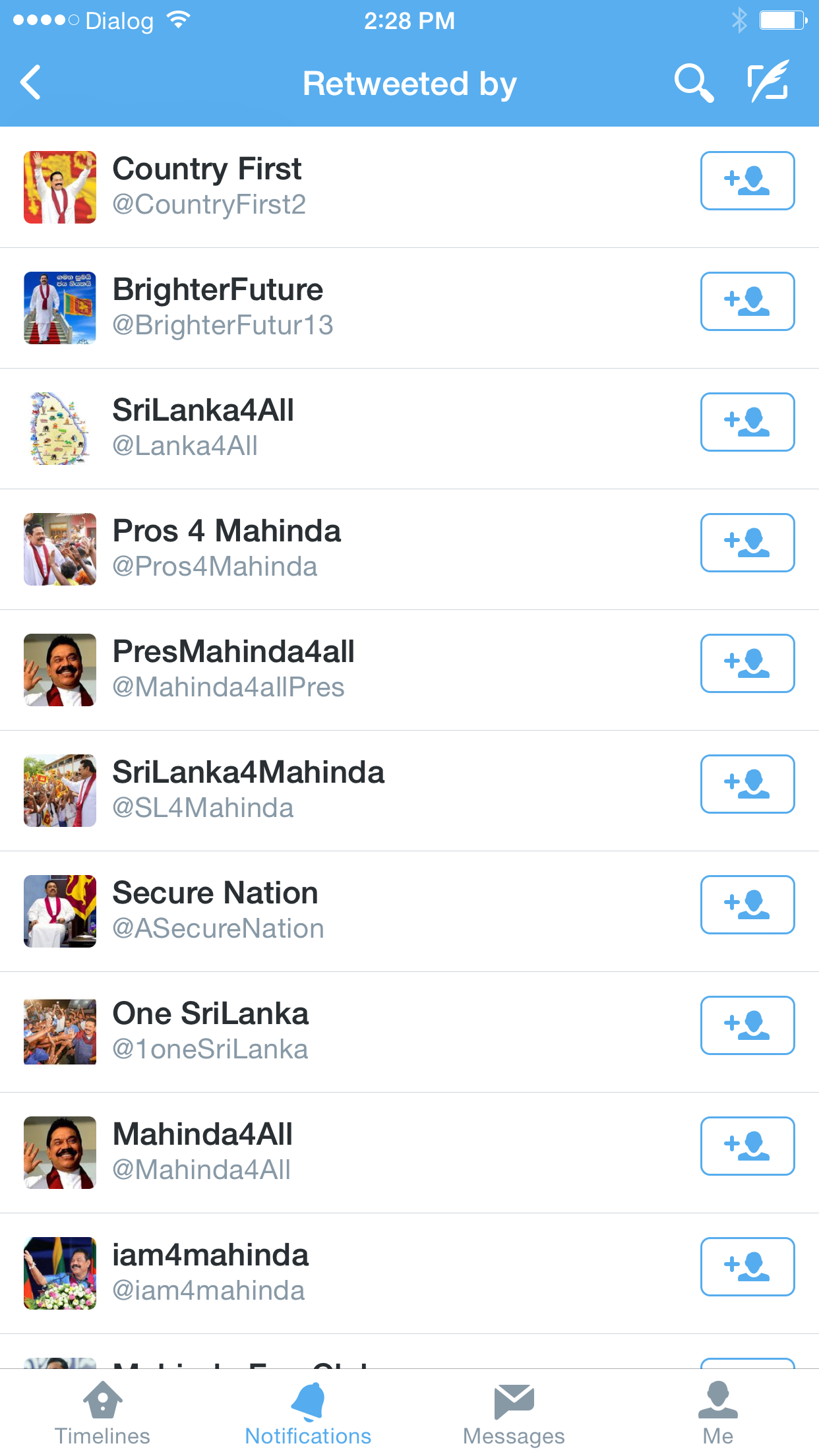On the same day the Centre for Policy Alternatives, through an online survey, flagged the importance of social media in the up-coming Presidential Election to reach young voters, a series of retweets offered a glimpse into the strategic social media eco-system supporting the re-election of the incumbent President, Mahinda Rajapaksa.
At 2.17pm today, @mahinda4slanka published the tweet above, including in it the account of Groundviews on Twitter.
In the same minute, 15 other accounts had re-published this tweet.
It’s virtually impossible for this number of accounts, all pro-Rajapaksa, to under a minute retweet the same content by chance or coincidence. What we see here is a revealing glimpse into a Twitter network managed by the President’s election campaign, or allied groups under contract, to generate and disseminate content in favour of the incumbent.
An analysis of the accounts are revealing. Follower counts were accurate at the time of writing.
- @mahinda4slanka (original tweet) – Started 7th December 2014, 89 followers
- @CountryFirst2 – Started 16 December 2014, 29 followers
- @Lanka4All – Started 16 December 2014, 25 followers
- @BrighterFutur13 – Started 16 December 2014, 7 followers
- @Pros4Mahinda – Started 16 December 2014, 22 followers
- @Mahinda4allPres – Started 15 December 2014, 13 followers
- @1oneSriLanka – Started 15 December 2014, 16 followers
- @SL4Mahinda – Started 15 December 2014, 5 followers
- @Mahinda4All – Started 15 December 2014, 13 followers
- @ASecureNation – Started 15 December 2014, 14 followers
- @Mahinda4Sl – Started 7 December 2014, 45 followers
- @iam4mahinda – Started 7 December 2014, 47 followers
- @missionsrilanka – Started 6 December 2014, 33 followers
- @withmahinda – Started 7 December 2014, 44 followers
- @mahindafanclub – Started 7 December 2014, 45 followers
- @welovemahinda – Started 6 December 2014, 27 followers
Through analytics, even more interesting insights emerge. For example, if we take @Mahinda4Sl, @iam4mahinda and @mahindafanclub – all created on 7 December 2014 – it’s clear that they are updated the most at around the same time (6pm). In each account, the largest number of followers are also very new to Twitter, between 7 to 30 days old.
See these and other statistics for @Mahinda4Sl, @iam4mahinda and @mahindafanclub.
There is also a clearly discernible homiphily amongst the followers of these accounts, meaning that followers tend to largely overlap across the pro-Rajapaksa Twitter accounts. One can infer, given the very short time these accounts have been active on Twitter, that this is not an organic growth and is instead strongly indicative of cross-subscription to accounts managed by a common entity.
For example, see @CountryFirst2 and @Lanka4All (both started on 16 December), @Mahinda4allPres and @1oneSriLanka (both started on 15 December) and finally @withmahinda and @mahindafanclub (both started on 7 December).
With all the caveats usually associated with a web survey in Sri Lanka, the results of the online poll by the Centre for Policy Alternatives affirms what is generally held to be true – social media will play an important role in the mobilisation of votes amongst a younger demographic and perhaps even go as far as to influence who they vote for.
Based on a cursory analysis of these Twitter accounts alone (keeping in mind the President’s social media reach extends to a panoply of Facebook accounts, in addition to YouTube and even Instagram) it is extremely clear incumbent’s re-election campaign on web based social media is, by a long shot, far more sophisticated and carefully engineered than anything the Maithripala Sirisena coalition has, to date, even thought of.
As virtual extensions of the power and influence of real world party politics, these social media campaigns will be vital to observe in the weeks ahead, to see to what degree both leading candidates will go to in order to influence voters whose primary source of information around politics and the elections will be mediated through the very platforms Gotabaya Rajapaksa, the President’s all-powerful brother, once called a threat to national security.




